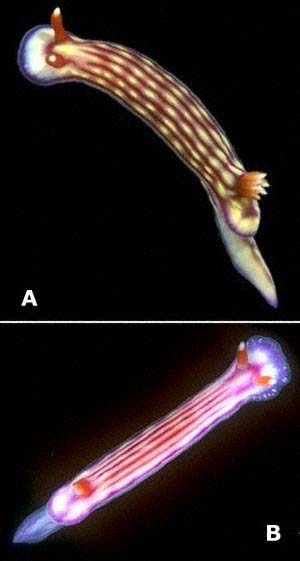
Hypselodoris whitei
(Adams & Reeve, 1850)
Order: NUDIBRANCHIA
Suborder: DORIDINA
Family: Chromodorididae
DISTRIBUTION
Tropical Western Pacific
PHOTO
UPPER RIGHT: A, Solitary Is, Coffs Harbour Region New South Wales, October 1990. B, juvenile, same locality, March 1988. PHOTOS: Bill Rudman.
LOWER LEFT: Ala Moana Beach Park, Honolulu, approx 3m, Hawaii. Insets showing white markings on gills and rhinophores. PHOTO: with permission from John Hoover.(Hawaiian section of Mike Miller's Slug Site ).
LOWER RIGHT: Koumac, New Caledonia, October 1993. PHOTO: Bill Rudman.
RELATED TOPIC
There are a group of white or yellow chromodorids with red or purple longitudinal lines, some of have been discussed previously (Rudman, 1977). Hypselodoris whitei, originally described from Indonesia, is also known from Enewetak Atoll, New Caledonia and the tropical East Australian coast. A name often used for this species is Hypselodoris mouaci. It has a whitish background colour with a reddish purple submarginal line around the mantle edge and a series of five longitudinal lines covering the rest of the mantle. These lines are usually very crooked and joined by a series of lateral connections, breaking the mantle into rows of slightly raised whitish regions. The rhinophores are orange to orange-red with a distinctive white tip and the gills are similarly coloured with white on the inside and usually at the tip of each gill. This species is very similarly coloured to H. maridadilus, from the Indian Ocean which has a more yellow background colour, and in which the longitudinal lines are distinctly purple and cross-connections very indistinct. The lines are also much straighter than in H. whitei, and the rhinophores and gills have no white markings. The specimens reported from Japan and Hawaii as H. hilaris and H. maridadilus are more similar in colour to the Indian Ocean species, but they have the white tipped rhinophores and white upper edge to the gills. The earliest name for this species is probably Doris lineata Eydoux & Souleyet, 1852, which was described and illustrated from Hawaii (Sandwich Is). However that name is preoccupied by Doris lineata Brocchi, 1819. See my March 1, 1999 reply to Clay Bryce for a discussion on H. centunculus Yonow, 1994 which has been superceded by Gosliner & Johnson (1999) who examined the anatomy of one of Yonow's specimens and concluded that it is identical to Hypselodoris whitei in features of the radula and mantle glands.
References:
• Gosliner, T.M. & Johnson, R.F. (1999) Phylogeny of Hypselodoris (Nudibranchia: Chromodorididae) with a review of the monophyletic clade of Indo-Pacific species, including descriptions of twelve new species. Zoological Journal of the Linnean Society, 125: 1-114.
• Rudman, W.B. (1977) Chromodorid opisthobranch Mollusca from East Africa and the tropical West Pacific. Zoological Journal of the Linnean Society, 61: 351-397.
•Yonow, N. (1994) Opisthobranchs from the Maldive Islands, including descriptions of seven new species (Mollusca: Gastropoda). Revue fr. Aquariol., 20(4): 97-130.
LOWER LEFT: Ala Moana Beach Park, Honolulu, approx 3m, Hawaii. Insets showing white markings on gills and rhinophores. PHOTO: with permission from John Hoover.(Hawaiian section of Mike Miller's Slug Site ). LOWER RIGHT: Koumac, New Caledonia, October 1993. PHOTO: Bill Rudman.
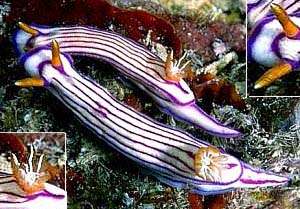
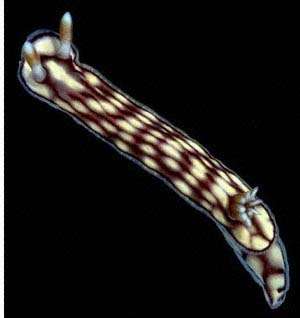
Rudman, W.B., 1999 (March 1) Hypselodoris whitei (Adams & Reeve, 1850). [In] Sea Slug Forum. Australian Museum, Sydney. Available from http://www.seaslugforum.net/find/hypswhit
Related messages
Hypselodoris whitei? laying eggs
August 22, 2008
From: Douglas Hansen
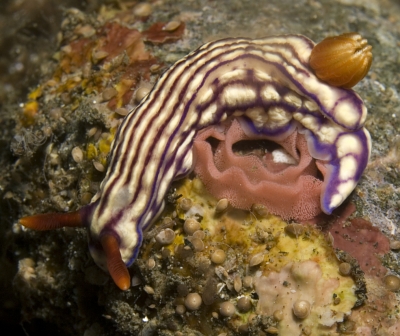
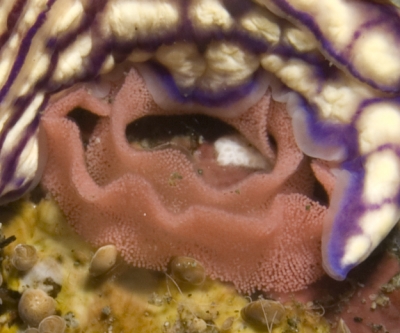
Concerning message #21369:
I believe this is a Hypselodoris whitei laying eggs. We found it in Milne Bay, Papua New Guinea.
Locality: Lawadi, Milne Bay, 12 feet, Papua New Guinea, Pacific, 10 November 2007, black sand. Length: 3.5 inches. Photographer: Douglas Hansen.
Douglas Hansen.
mhel0323@sbcglobal.net
Hansen, D.S., 2008 (Aug 22) Hypselodoris whitei? laying eggs. [Message in] Sea Slug Forum. Australian Museum, Sydney. Available from http://www.seaslugforum.net/find/21828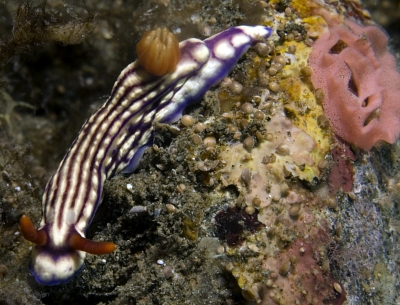
Thanks Doug,
Yes this is H. whitei. Although the white on the rhinophore tips and inside edge of the gills is not very obvious, it is clearly there. Concerning the egg ribbon - did you actually see it laying it? Why I ask is that since the egg-laying apparatus is on the right side of the body the photo doesn't actually show that the slug is laying the eggs. From your photos it is possible that the Hypselodoris is crawling off after completing the egg ribbon, but it could also be that it is just crawling over someone else's egg ribbon. Sorry I am hard to please, but we don't have a photo of this species' egg ribbon so it would be nice to be sure.
Best wishes,
Bill Rudman
Hypselodoris whitei? from Ningaloo Reef, WA
February 13, 2008
From: Kristin J Anderson
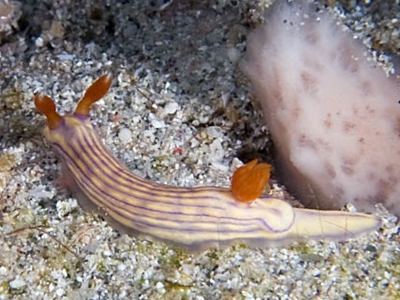

Not quite sure which of the similar Hypselodoris sp this little one is. Appreciate your help.
Locality: Ningaloo Reef, Exmouth, 12 m, Western Australia, Indian Ocean, Lighthouse Bay, 11 November 2007, limestone coral reef. Length: 2-2.5 cms. Photographer: Kristin Anderson.
Kristin Anderson
kristin@oceansbyanderson.com
Anderson, K. J., 2008 (Feb 13) Hypselodoris whitei? from Ningaloo Reef, WA. [Message in] Sea Slug Forum. Australian Museum, Sydney. Available from http://www.seaslugforum.net/find/21369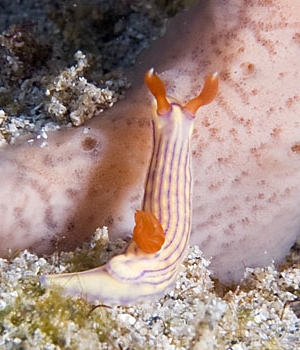
Dear Kristin,
It looks as though Hypselodoris whitei and H. maridadilus will haunt me for ever. As you will see from the various discussions accompanying messages on both species, I have some doubts about whether there are one or two species. The form with white-tipped rhinophores is typical of the west Pacific species, H. whitei, so even though yours is from the Indian Ocean it is best to consider it to be H. whitei. As you will see we have records of this white-tipped form from the Maldives, so either the two species overlap in the eastern Indian Ocean or the this is where the colour forms of one species merge.
Best wishes,
Bill Rudman
Mating Hypselodoris whitei: size and maturity ?
October 3, 2007
From: Kamal El Tawil
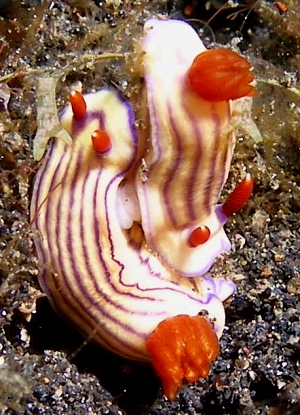
Dear Bill,
The two mating Hypselodoris whitei are very small in size (10-12 mms) while the single animal in the second picture is significantly bigger (40 mms).
Would this be an indication of early maturity in this species ? or is size irrelevant here ? I understand that nudibranchs can reach maturity in a few days or in a few months in different species (message #6464 ).
Locality: Lembeh Straight, N.E. Sulawesi, 10-12 metres, Indonesia, Celebes sea, 12 August 2007, Muddy. Length: 10-12 mms. Photographer: Kamal El Tawil.
Kind regards,
Kamal El Tawil
www.coralworld.net
kt@coralworld.net
El Tawil, K., 2007 (Oct 3) Mating Hypselodoris whitei: size and maturity ?. [Message in] Sea Slug Forum. Australian Museum, Sydney. Available from http://www.seaslugforum.net/find/20855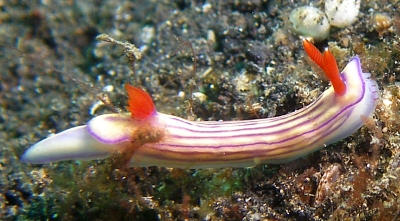
Dear Kamal,
As I discuss on the lifespan Fact Sheet, nudibranchs are very variable in lifespan and age of maturity although as a general rule I think we can say that those that grow to maturity very rapidly usually only live a short time [couple of months or less]. Most species seem to live for about a year and many reach maturity quite early - but usually the male parts develop to maturity first so you will see large and small animals pairing up. In these cases the small one possibly stores its partners sperm until it developes fertile eggs. In the case you have here it is possible that neither animal has a mature female system so perhaps they will both store their partner's sperm for a month or so until they have fertile eggs.
We have little information on growth rates of most nudibranchs so I am ashamed to say I have no idea how long it will take your small animals to reach the size of the larger one.
Best wishes,
Bill Rudman
Hypselodoris whitei? from Bali
February 22, 2006
From: Marli Wakeling

Hi Bill,
Until I scanned these beauties, I assumed they were Hypselodoris emma. Now I realize there are too many lines. Is this Hypselodoris whitei or Hypselodoris maridadilus? It looks more like the latter, but the locale fits the former better.
Locality: Tulamben, Bali, Indonesia. Depth: 20 feet. Length: 20 mm. 23 July 2005. Sand and rubble slope. Photographer: Marli Wakeling
Cheers,
Marli
scubamarli@gmail.com
Wakeling, M., 2006 (Feb 22) Hypselodoris whitei? from Bali. [Message in] Sea Slug Forum. Australian Museum, Sydney. Available from http://www.seaslugforum.net/find/15181Dear Marli,
These two species may turn out to be geographical forms of one species. The only consistent colour difference seems to be that the Pacific H. whitei has white-tipped rhinophores while the Indian Ocean H. maridadilus does not. For that reason I would identify yours as H. whitei.
Best wishes,
Bill Rudman
Re: Hypselodoris whitei? from Solomons
March 23, 2005
From: Barbara Hanchard
Bill,
Just to acknowledge your help with IDing the H. whitei and the suggestions for using the Forum data search more efficiently [#13361 ]. Obviously a new user. I was diving regularly with Bruce Potter, a contributor I believe until he left (not by choice) the Solomons earlier this year. I look forward to further exchanges and once again thanks for your expert help.
Regards
Barbara
barbara.hanchard@ffa.int
Hanchard, N.B, 2005 (Mar 23) Re: Hypselodoris whitei? from Solomons. [Message in] Sea Slug Forum. Australian Museum, Sydney. Available from http://www.seaslugforum.net/find/13365Dear Barbara,
Sorry to hear Bruce is no longer in the Solomons. I too look forward to further exchanges from you.
Best wishes,
Bill Rudman
Hypselodoris whitei? from Solomons
March 19, 2005
From: Barbara Hanchard

Grateful for help with ID of this animal. Helmut Debelius's book shows a similar animal labelled H. mouaci but I see no reference to this in your species list. Confused.
Locality: Boneghi Beach (2), Honiara, Solomon Islands. Depth: 2 meters. Length: 2 mm. 5 March 2005. sandy bottom. Photographer: Barbara Hanchard.
Barbara Hanchard.
barbara.hanchard@ffa.int
Hanchard, N.B., 2005 (Mar 19) Hypselodoris whitei? from Solomons. [Message in] Sea Slug Forum. Australian Museum, Sydney. Available from http://www.seaslugforum.net/find/13361Dear Barbara,
Yes this is Hypselodoris whitei. If you have a look at the species' Fact Sheet I have mentioned that H. mouaci is the same species. When you are using the Forum it always pays to use the Forum Search facility as often names, which are not in the Species List, are mentioned elsewhere in messages or other general information. It also pays to split names up. For example if Hypselodoris mouaci doesn't produce results, try searching for mouaci, because in some cases the genus name [Hypselodoris] may be different in the Forum.
Sorry that names change but as we learn more we find that what we thought were two species are in fact only one - so we keep the oldest name. Sometimes we find we haven't been using the oldest name for a species, so we have to change the name in use to meet this rule. It sounds a bit messy, but I can assure you it would be even messier id there were no rules to follow.
Best wishes,
Bill Rudman
Hypselodoris whitei f rom Bali
April 4, 2003
From: Danny Van Belle

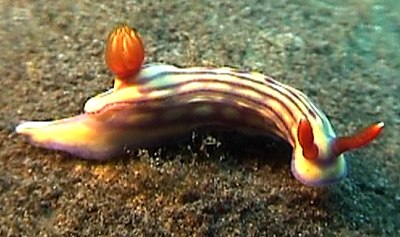
Hi Bill,
Here I'm again with some nudi's filmed at Tulamben, North-east coast of Bali, Indonesia in May 2000.
Depth around 5 meters.
Best regards
Danny Van Belle
dannyvb@hotmail.com
Van Belle, D., 2003 (Apr 4) Hypselodoris whitei f rom Bali. [Message in] Sea Slug Forum. Australian Museum, Sydney. Available from http://www.seaslugforum.net/find/9522Thanks Danny,
This is Hypselodoris whitei. It differs from the Indian Ocean H. maridadilus in having white or translucent tips to the gills and rhinophores. It is possible that they are colour forms of one species.
Best wishes,
Bill Rudman
Hypselodoris whitei - feeding
April 4, 2003
From: Danny Van Belle
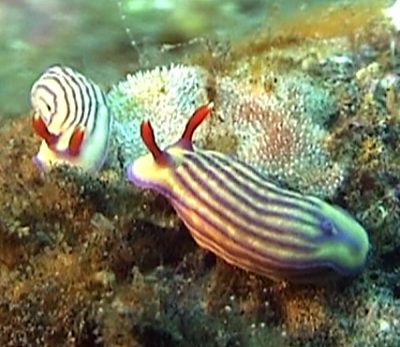

Hi Bill,
To accompany my other message here are two more photos from Tulamben, Indonesia showing two other Hypselodoris whitei feeding on .........?
Best regards
Danny
dannyvb@hotmail.com
Van Belle, D., 2003 (Apr 4) Hypselodoris whitei - feeding. [Message in] Sea Slug Forum. Australian Museum, Sydney. Available from http://www.seaslugforum.net/find/9524Thanks Danny,
If they are feeding it will be on a sponge. I suspect the whitish masses behind them are a sponge colony they have already dealt with, and they are now trying to find the rest of it in the algal growth they are sitting on. It could be a nice feeding record.
Best wishes,
Bill Rudman
Hypselodoris whitei from Philippines
October 22, 2002
From: Erwin Koehler
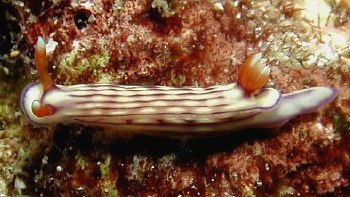
Dear Bill,
Here is one more from the Philippines, Apo Island, divesite "Cogon". Is it Hypselodoris whitei or Hypselodoris maridadilus or something else?
Data:
Size: 21mm
Depth: 15m
Date: 06 March 2002
Erwin
Erwin@medslugs.de
Koehler, E., 2002 (Oct 22) Hypselodoris whitei from Philippines. [Message in] Sea Slug Forum. Australian Museum, Sydney. Available from http://www.seaslugforum.net/find/7749Dear Erwin,
This is Hypselodoris whitei
Best wishes,
Bill Rudman
Hypselodoris whitei from Malaysia
July 18, 2002
From: Richard Houghton
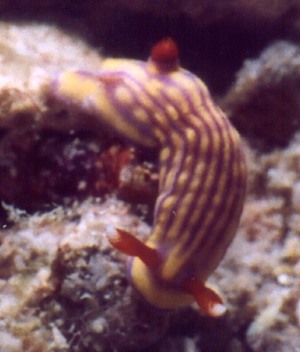
Dear Bill,
This is from Pulau Aur, Malaysia. Found in 10 metres of water on it's own, though close to other species. 25mm in length. June 2002.
Rich
richard_houghton@hotmail.com
Houghton, R., 2002 (Jul 18) Hypselodoris whitei from Malaysia. [Message in] Sea Slug Forum. Australian Museum, Sydney. Available from http://www.seaslugforum.net/find/7507Dear Rich,
This is Hypselodoris whitei.
Best wishes,
Bill Rudman
Hypselodoris whitei from Malaysia
April 30, 2002
From: John Yap
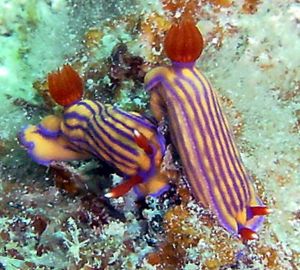
Hi Bill,
Can you help me identify this pair of nudibranch? I found them at about 6 metres of waters near Pulau Aur, an island east of West Malaysia (17 Mar 2002). They were about 1.5 cm long and bearly moving. Perhaps juveniles?
Cheers!
John Yap
johnyap@tp.edu.sg
Yap, J., 2002 (Apr 30) Hypselodoris whitei from Malaysia. [Message in] Sea Slug Forum. Australian Museum, Sydney. Available from http://www.seaslugforum.net/find/6656Dear John,
This spectacular animal is Hypselodoris whitei.
Best wishes,
Bill Rudman
Re: Hypselodoris maridadilus? from Maldives
December 4, 2001
From: Erwin Köhler
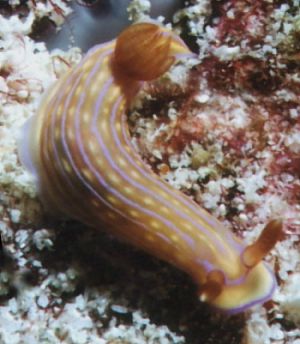
Dear Bill
Here is one more shot of the one you labeled Hypselodoris maridadilus on October 28, 2000
I think it looks like Hypselodoris centuculus Yonow, 1994. Is this id ok? Is this species valid?
Erwin
Erwin@medslugs.de
Köhler, E., 2001 (Dec 4) Re: Hypselodoris maridadilus? from Maldives. [Message in] Sea Slug Forum. Australian Museum, Sydney. Available from http://www.seaslugforum.net/find/5772Dear Erwin,
As I said in reply to Valda Fraser's message, your animal does look identical to Nathalie Yonow's photo of H. centunculus. I had previously thought that H. centunculus was most probably a colour variant of H. maridadilus [see comments on Clay Bryce's message], but Gosliner & Johnson (1999) have examined the anatomy of one of Yonow's specimens and conclude from that it is identical to Hypselodoris whitei in features of the radula and mantle glands. The white tipped rhinophores are also found in H. whitei. So in brief, your animal does look like H. centunculus, but that species is in fact a synonym of the much older H. whitei.
Best wishes,
Bill Rudman
Hypselodoris whitei from NE Sulawesi
August 11, 2001
From: Jim Anderson
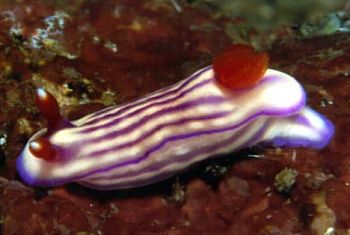
Dear Dr. Rudman,
Can you identify this animal? It looks to me like the 'Beautiful Hypselodoris' in Neville Coleman's recent publication. It was photographed at Police Pier in Lembeh Strait on 22 June 01 at 18 metres. It was approx 25 mm long.
Regards,
Jim A
jander4454@aol.com
Anderson, J., 2001 (Aug 11) Hypselodoris whitei from NE Sulawesi. [Message in] Sea Slug Forum. Australian Museum, Sydney. Available from http://www.seaslugforum.net/find/5003Dear Jim,
This is Hypselodoris whitei.
Best wishes,
Bill Rudman.
Hypselodoris maridadilus from Maldives
October 28, 2000
From: Erwin Koehler

Dear Bill,
This one is from the Maldives, Felidhoo Atoll, Vashu Giri Island, divesite "Vashi Thila", depth 12m, size 21mm, September 19, 2000.
Erwin
Medslugs.Koehler@t-online.de
Koehler, E., 2000 (Oct 28) Hypselodoris maridadilus from Maldives. [Message in] Sea Slug Forum. Australian Museum, Sydney. Available from http://www.seaslugforum.net/find/3247Dear Erwin,
I am pretty sure this is Hypselodoris maridadilus. It looks a bit different from normal, with a more translucent colour pattern, but in all major features it is identical.
Best wishes,
Bill Rudman.
Hypselodoris whitei from Sulawesi
March 24, 2000
From: Lindsay Warren


Dear Bill
Nikki Rowlands found the first specimen (OS0623) of what I think may be
Hypselodoris whitei late afternoon on 10 August 1999 at a depth of 6.2 m on sand on the reef flat on Karang Kaledupa [Tukang Besi Archipelago, SE Sulawesi, Indonesia - Operation Wallacea]. Size: 25 mm.
The second specimen (OS0633) was found by Imogen Hutter on 12 August 1999 on the same atoll but at a different location. Size: 7 mm. PHOTOS: Lindsay Warren.
Unfortunately we did not make notes regarding its colouration as we thought it was H. mouaci as per Debelius's book. However, having read your entries on the Forum I realise that we should have paid more attention. Nevertheless in both cases the rhinophores are tipped with white and I
think there is a hint of white on the inside of the gills of the larger specimen.
What do you think?
All the best
Lindsay Warren
100014.2112@compuserve.com
Warren, L., 2000 (Mar 24) Hypselodoris whitei from Sulawesi. [Message in] Sea Slug Forum. Australian Museum, Sydney. Available from http://www.seaslugforum.net/find/2144Dear Lindsay,
Yes I think this can be considered 'typical' H. whitei. If we are correct, H. moauci is a synonym.
Best wishes,
Bill Rudman.
Hypselodoris whitei from the Marshalls
February 15, 2000
From: Scott Johnson

Hi Bill,
Attached are three shots of Hypselodoris whitei from the Marshall Islands for comparison with the H. whitei? I sent earlier. In two of these, the animals are feeding on their preferred food source, a purple sponge. In the top photo, you can see how they've eaten out between the skeletal fibers above the pair of animals. These were all photographed at Enewetak Atoll.
Scott
johnson@kmr.ll.mit.edu


Dear Scott,
Thanks for these photos. They clearly show the oblique purple lines on the foot which are present in the painting of this species in Adams & Reeve's (1850) original description. To my knowledge this is the only purple-lined species which has these diagonal lines on the foot.
Best wishes,
Bill Rudman.
